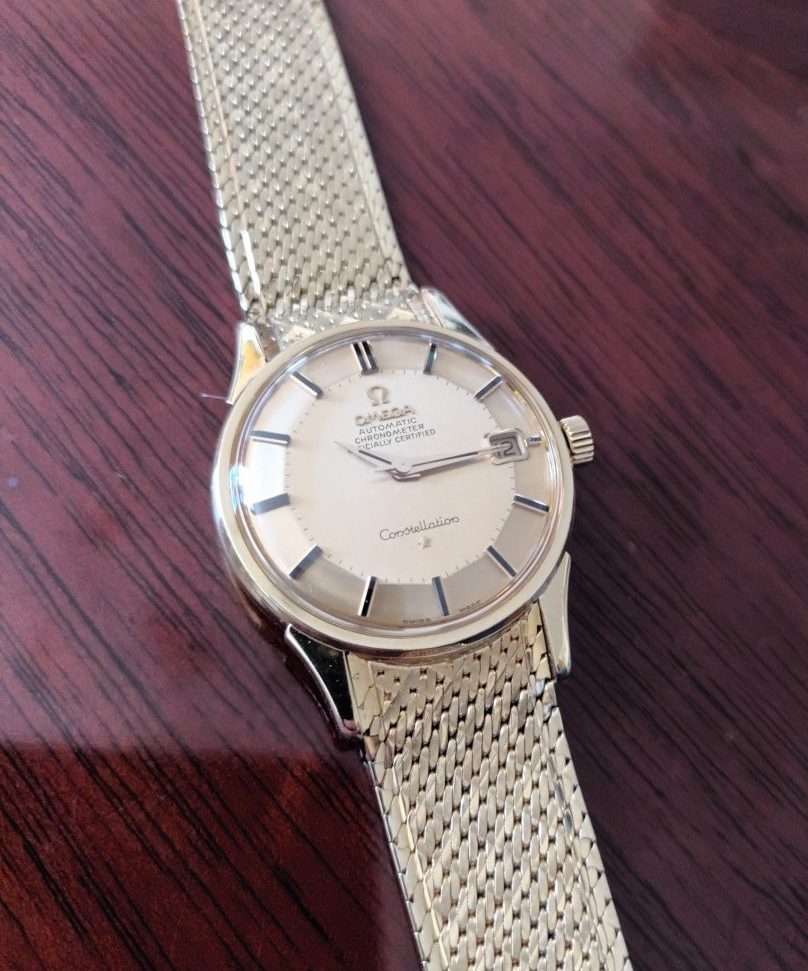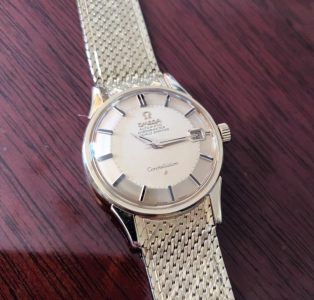I first had a hankering for a “Pie Pan” dial model some 15 years ago, and eventually bought one a few years later. This was quite by chance when I popped into Fenwicks on Bond Street, and descended to their men’s dept. Whilst there I noticed a few old display cabinets which contained a variety of antique trinkets – jewellery, accessories, and a few watches. These mini outlets were run by a company called Foundwell who I later discovered was US-based but run by an ex-Londoner. They appear to specialise in this kind of symbiotic relationship. Anyway, within one cabinet was a mid-sixties stainless steel Omega “Pie Pan” with date, and it seemed in decent condition. There were no papers or box – save for a note from the retailer and one of their boxes. It was up at some £1,400, however I bargained and I think I bought for £1,250 in the end. As the dial had a cross-hair on it, I thought it may be a bit special, so waltzed round to the Omega boutique. This was not entirely successful as it was manned by 20 year old somethings who knew little about their employer’s older models. That said, one did go onto their computer and into Omega’s archive, but we could not find an exact match. However, there was one quite similar so they printed off an image for me. I left reasonably content that I had not been stitched up and that was that – until last year. In the interim, I had worn the watch a little. It actually ran fine, but in common with many older watches it had a worn and small crown, plus no quick date set, so the practicality of wearing it was it a bit of a trial. In the end, I got a bit fed up, so got in touch with James Kibble for an assessment with a view to sell. With what seemed indecent haste, James came back to me and said he thought that although the movement was OK, the dial had been meddled with – one pointer being that the Constellation star at 6 o’clock was slightly askew – something I had not noticed. A couple of other aspects were also pointed out, one being that the hands were an odd colour – too gold. Needless to say I was pretty cheesed off. As a result James could not take it in – even after I said “divulge all and ask maybe £800 for it”! All he could suggest was putting it to auction at a mere £600, and a dealer would probably buy and rectify.
In the end I did nothing until earlier this year when a travelling “dealer” came to town, buying gold and all sorts. I did in fact have some “scrap” gold jewellery so took that, along with the Omega and a few other “cheapies”. The chap gave me a price for the gold, but was also interested in the watches, all of which he studied intently with a loupe. In the end he gave a me a price for the lot (the Omega possibly equating to some £500), which I accepted. He actually did pretty well overall and, was, after all the “professional”, so I had few qualms about playing a bit thick! So, a salutary lesson. Either really know your watches or buy from a reputable dealer!
Moving on, readers will know that I bought a Constellation C case from Parkers in Sheffield late last year and wrote about it back in March. Although a lovely watch, it never quite hit the spot. So, when a watch sale came up at my local auctioneers a few months ago, I was more than interested to notice that an 18ct Constellation “Pie Pan” on a bracelet was one of the lots. I think the estimate was some £2k – 2.5k which I thought was pretty low. Anyway, I went and had a look and it was really good, with an original box – but no papers. It was also working! By this time I was a bit more au fait with older Omegas, plus, did more research. As such I decided to bid, and eventually secured for around £3.1k (including commission and VAT).
I wore the watch for a bit and it ran very accurately, however, it was apparent that all was not entirely fine as it would occasionally run out of steam a bit too quickly. Also, again, the crown was small and worn. At this point I had to cast around for a decent watchmaker to use. Now, you may think that I would have had that sorted years ago, but that was not really the case. Yes, I have used – let us say half a dozen, but I have had issues with most. Either they; totally underestimate (lie) over the timeframe the work will take, are too expensive, will not do as you wish, or are just po-faced and rather arrogant. Some are all of these! One who has none of these faults is my mate Rich at The Watch Spot. He is pretty fast, very reasonable, amenable to discussing options, and also friendly. The only problem for me is that he will not touch any expensive or precious metal models! Anyway, after moaning to a few people I was recommended a relatively new firm based in Berkshire. I will simply refer to them as X and will return to them later on. To the watch now!
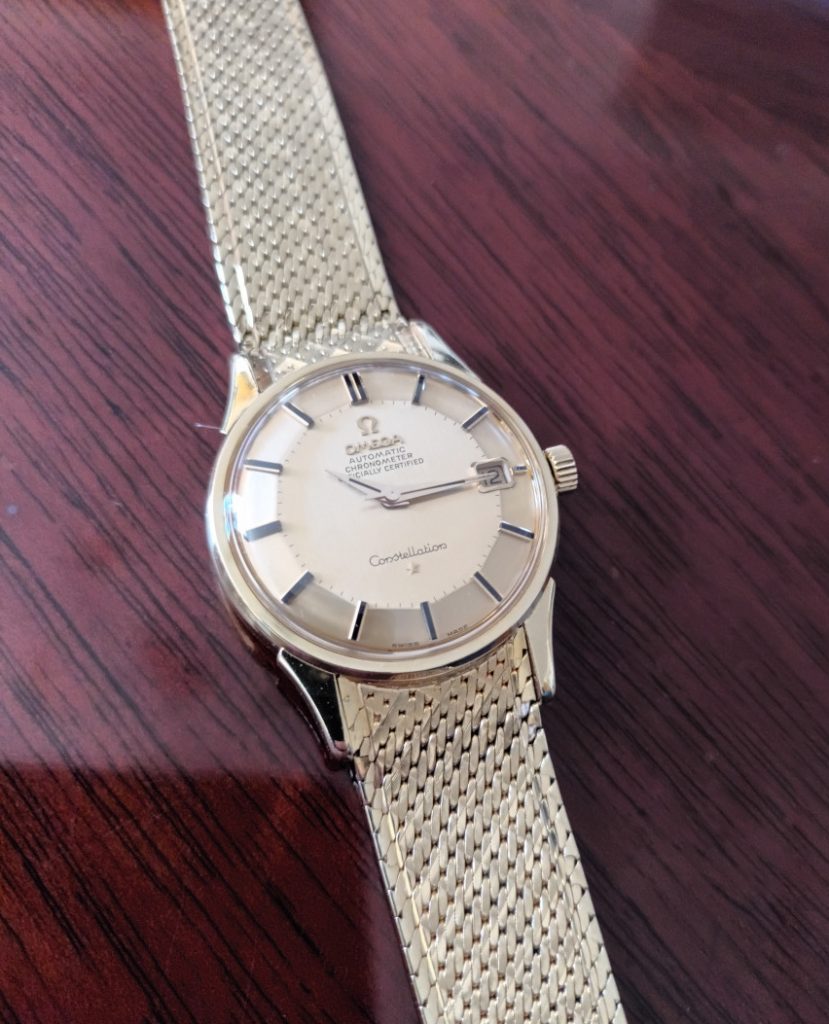
The watch in question is a Constellation ref 1685415 in 18ct yellow gold, with a “Pie Pan” gold dial with date. This is on a lovely gold “woven” Milanese/mesh bracelet. The case is UK hallmarked – Birmingham 1965, but the bracelet is London 1966. I have checked an Omega serial number database and this confirms a manufacturing date of 1965, but the watch clearly could not have been retailed for another year. Alas, as there are no original papers I also have no chronometer rating. At some point I may approach Omega for more detailed records.
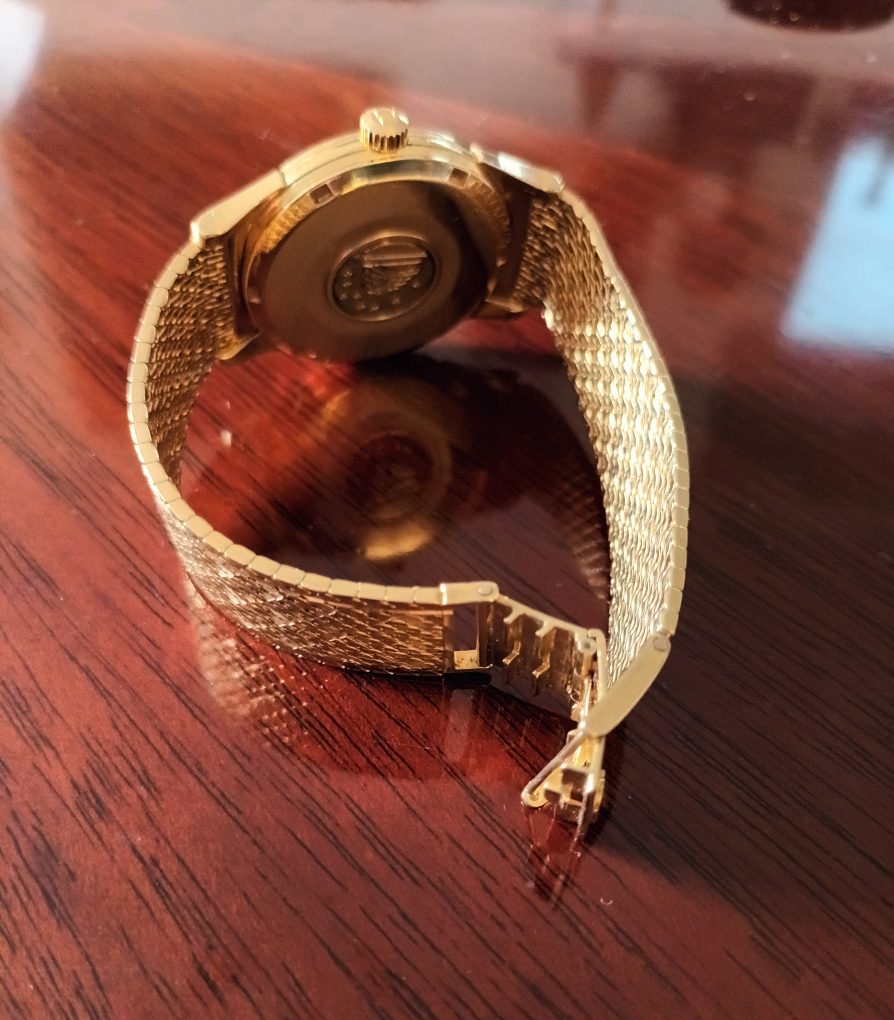
There is probably not much point is doing a really in-depth review/description as these watches are well-known – generically at least. Suffice to say that in this configuration they are pretty rare. But some comment is worthy. So, the case is some 34mm, round, but softened by the fairly delicate lugs and the thin plain bezel. All is polished – so no brushing here. The crown is of a decent size, fluted, and with the Omega sign atop (see later on for more details. Ed). The case rear is solid and has the usual Observatory engraving along with the eight precision award stars. The dial itself is gold – literally. The hour markers are raised rectangular battens infilled with black – sometimes referred to as ebony or black onyx. The one at 3 o’clock is tiny as the date window impinges. This is framed and the date wheel is gold-coloured with the Arabic numerals in black. A very fine minute track then occurs. The main hands are dagger shaped – gold with a fine black infill. The second hand is a plain fine gold needle. To the actual dial – well, this has fine brushing and, up to the battens is flat, but then it curves right down. The effect of this, and the straight sections in-between the battens, is a fluting effect – hence the nomenclature “Pie Pan”. All this is covered by something called “armoured glass”!
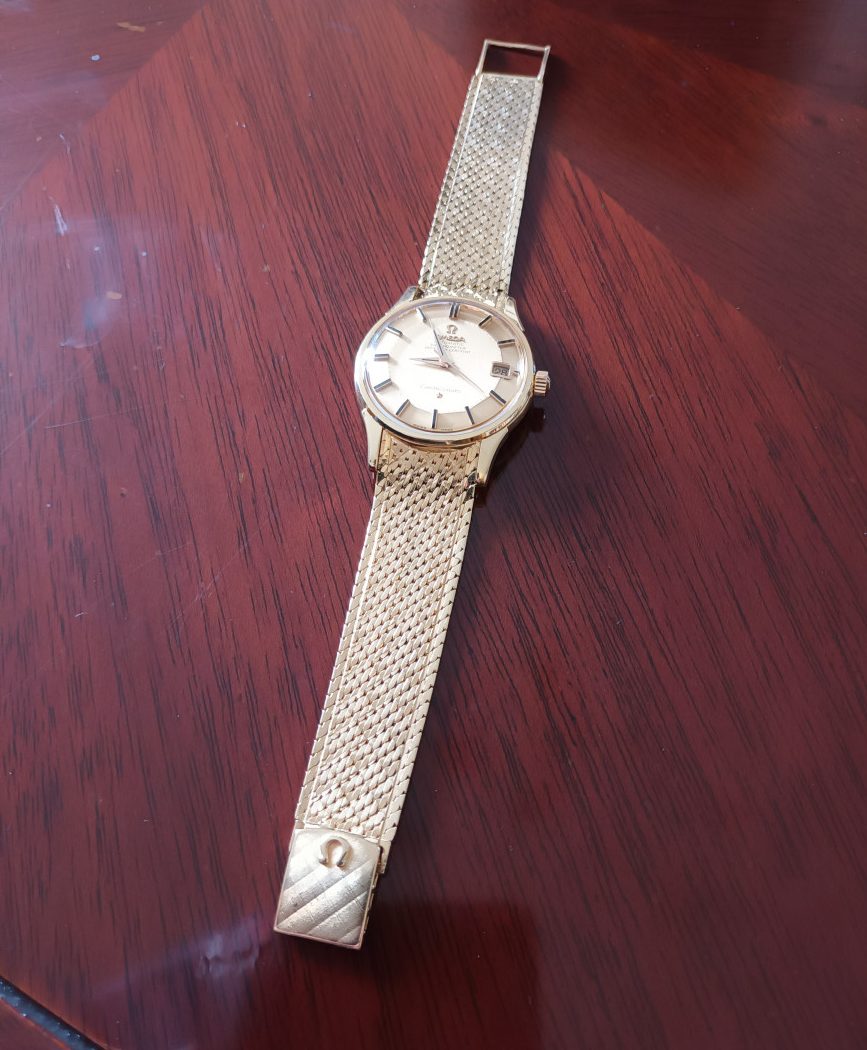
Turning to motive power, this is caliber 568, designed in the early 1950’s when the first Constellation was born. So, an automatic, and here with a semi-quick-set date feature. The caliber sports 24 jewels, a beat of 19,800 vph, and an approximate power reserve of 48 hours. Adjustment was carried out in five positions and temperature. Being chronometer rated, the movement would have been one of the best in it’s day, and still pretty fantastic today.
Lastly, that bracelet. It is a real work of art really, and describing it is not too easy so just refer to the images! However, it is just beautiful, elegant and so slinky! It is attached to the case so no popping a spring bar here. The clasp is the fairly usual Omega type – with an adjustable ratchet/security lock which also provides for three lengths. This alone was an expensive option and the overall price would have been up there with one of the Luxe versions. Omega sub-contracted out the manufacture of such bracelets to at least two, but possibly more craftsmen.
Returning to the servicing aspect, I spoke to the firm X and then sent the watch to them. They came back pretty quickly saying that the watch needed a new mainspring, plus the cost for replacing the scratched glass (generic as an original was rather dear), and the crown too, as this was worn. The latter I in fact supplied from the parts changed (but retained) when the C case was serviced by Omega. This was because Omega cannot seem to supply an exact match for these old Constellations, but instead offer a generic one, which to my mind is too plain and large. Anyway, the price estimate seemed pretty fair so I agreed to proceed and that was that for a couple of months. There was some contact in-between, but eventually the call came through that the watch was finished. An invoice was provided which was a little over £300. I had, by the way, received a 10% discount off the labour charge due to being a referred new customer. I received the watch a few days later and all seemed good. I wore for a few days and noted that the watch kept very good time. However, I then decided to take some photos for this article, and whilst doing one of the dial, noticed something rather odd. Was it my imagination, or was the sweep hand stuttering sometimes? I peered at it more closely and sure enough, when it reached 2 o’clock it seemed to stop then do a large jump – this occurred about four times until it reached 4 o’clock, then behaved normally again. Needless to say I contacted X the next day, and initially was told that being an old watch this was not unusual – the inference being just suck it up! I then had occasion to speak to a contact of mine, who although mainly a clock specialist, of course knows about watches too. I explained the issue to him and he immediately said that it sounded like the the “lyre” spring had not been adjusted correctly. I had actually never heard of this component. So, I took a short video of the dial and sent all off to X. I had a pretty quick response and they admitted that this was not right and I needed to return the watch – at their cost. So, the watch went back for this repair.
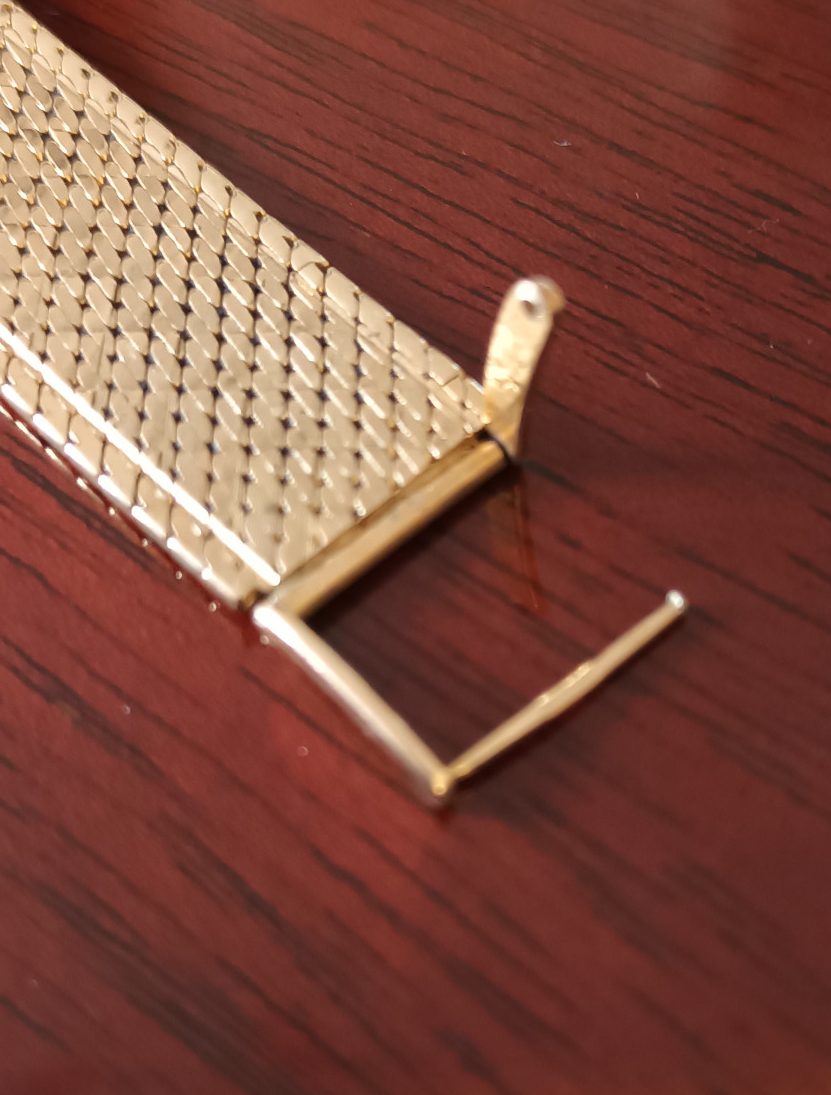
At the same time I must now admit a disaster, in that I broke the bracelet! This was partly my fault – but mainly the original maker of the bracelet! I had previously noticed that on the minimum size setting, the ratchet on the clasp did not locate properly. With some fiddling it sometimes would locate but sometimes did not. I had identified that one of the ratchet “bumps” that the bar hooks over had not been quite positioned accurately when made. This was proven when I compared it to the identical system on my C case. Anyway, when I first got the watch back I had been fiddling with the clasp, trying to push it down to locate the bar, when suddenly, pop, one end came out of it’s socket. To say I was livid was an understatement, as I knew this would not be an easy fix. I mentioned this to X (and sent images) and they said they knew a jeweller who could help. Great I thought, the watch could be fixed in one go. After a week I was informed by the firm that the watch was now fixed (no explanation of what had gone wrong) and irritatingly, they now said that the jeweller could not help after all. I got the watch back a few days later and the sweep hand was now moving seamlessly, but of course still could not wear!
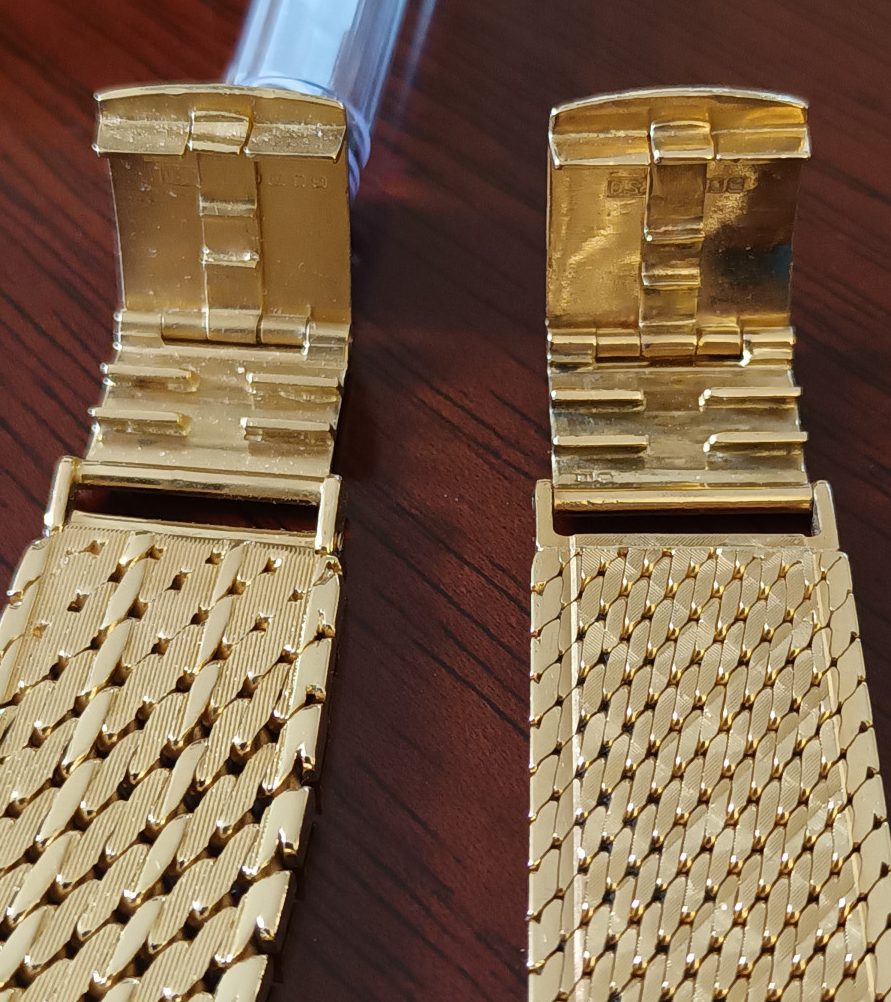
So, what to do? I contacted a couple of watch folks but they could not assist. I was then watching The Antiques Road Show, and one of their watch experts was on – Alastair Chandler. I thought he would have a business (most do), and sure enough The Clock Clinic popped up, so made contact. Sadly, they too could not mend the bracelet, but kindly referred me to a jewellery spot in Surrey – Boormans. Again I made contact, with images etc. They came back quickly and positively!! Apparently they have a precision PUK laser welder – which was what was needed. Anyway, I sent the watch off again, and within a week or so it was back looking as if nothing had happened. It was also done at what I felt was a very reasonable price. So, they are a recommend for jewellery repairs – but sadly they do not do watch servicing!
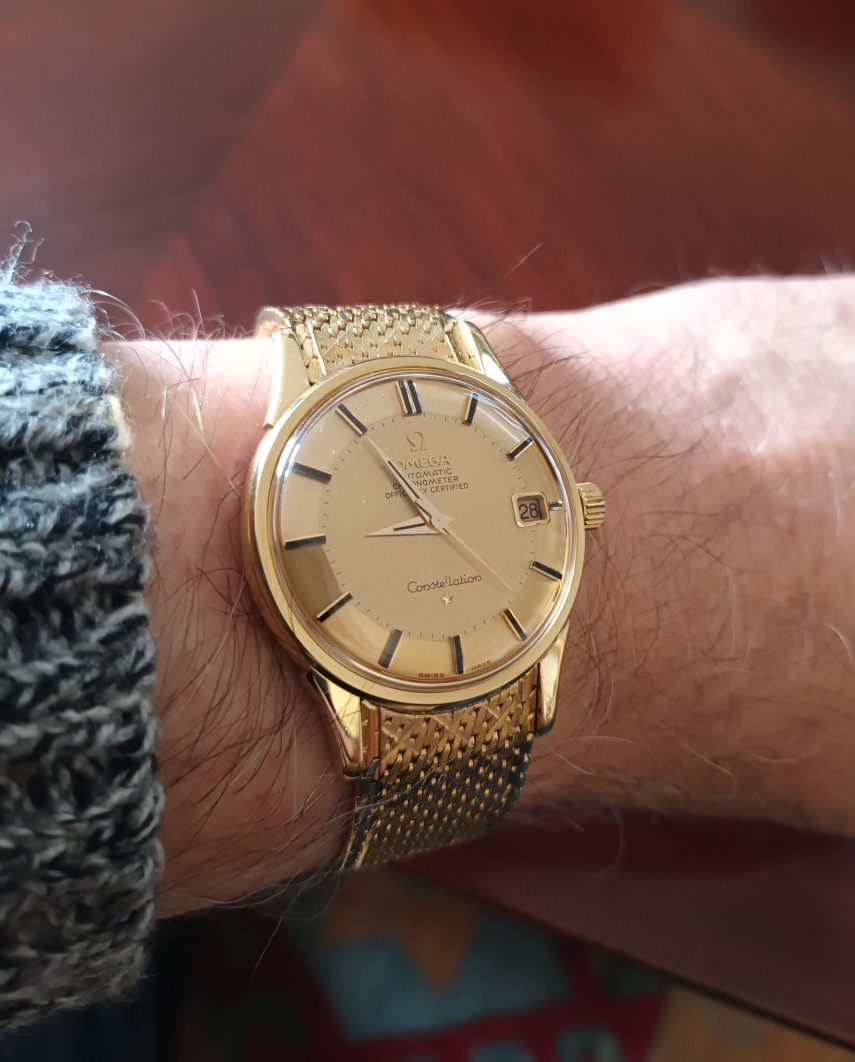
So, in conclusion, I really like the watch and it potentially should be a keeper. Iconic? Well, I think it meets all the usual criteria! In terms of what I paid, I think I did very well, as from what I can see on the internet the watch is worth at least £6k.
But what of firm X? Well, initially they did ask if I could rate them on Trustpilot as they were a fairly new enterprise – but that was before the problem(s). In all truth, I felt I could not give them a positive rating or recommend them, but decided not to name and shame as it may have been a one-off teething issue, and other reports have been OK. However, if they read this – I would just say, “you should never have returned the watch with such an obvious defect, plus, you should have ‘fessed up about what had gone wrong”. I just hope that the actual service/repair has been done properly – as I write I think so, and as such the cost was quite reasonable. But, I am still on the lookout for the ideal watch repair/servicing business!!
Words & Images: The Writer.

